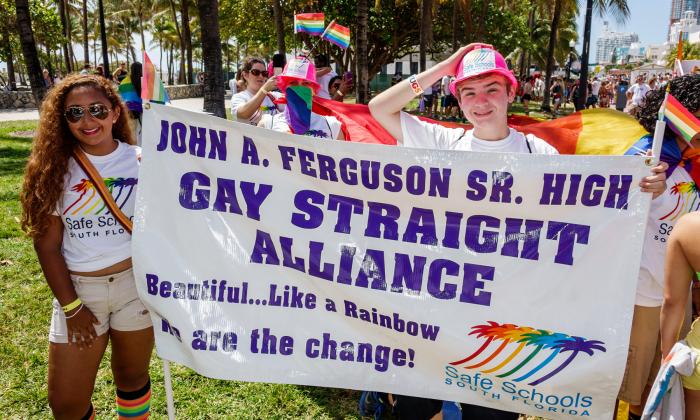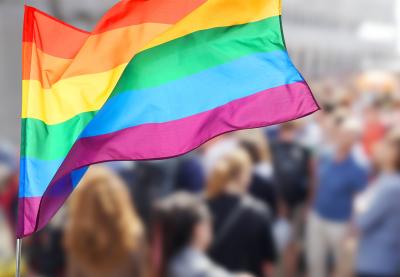To feel safe and to feel seen. To feel valued and to feel capable of growth. These are simple concepts—basic pillars of student achievement and the results of good pedagogy.
For many LGBTQ students, these rights remain out of reach.
According to data from GLSEN—an organization that provides resources, research and advocacy in support of queer youth—more than half of LGBTQ students feel unsafe at school. Fewer than 25 percent of those students see positive representations of queer people in their classrooms; more than half hear negative remarks about their sexuality or gender identity from school staff. And due to these and other circumstances, LGBTQ students are more likely to miss school, experience homelessness and see their grades suffer.
There is also much hope, but hope requires action. For the LGBTQ students who go to school in a fully inclusive environment—where both curriculum and schoolwide policies value their identities—we see more positive outcomes. These students experience less harassment, feel more valued by school staff and face fewer barriers to success.
We also know that an LGBTQ-inclusive school benefits all students. Seeing LGBTQ identities valued in the classroom, in the curriculum and in day-to-day interactions inspires empathy, understanding and respect. The overall school climate is safer. The lessons on history, literature and culture are more complete. And the dangerous expectations of performed gender roles—from the mask of suppressed emotional expression placed on boys to the unrealistic beauty standards facing girls—can give way to a culture that values all students. With our new guide Best Practices for Serving LGBTQ Students, we hope to help more schools adopt pedagogy and practices that can help all students feel safe, seen and capable of success. Read this excerpt, download the full guide and be a voice for change in your school this year!
Want to better support LGBTQ students in your classroom? Our webinar "LGBTQ Best Practices: Classroom Culture and Curriculum" models how to create an inclusive classroom culture and build an intersectional curriculum that incorporates queer history and perspectives.
Policy Checkup
Policies do not only reflect a school’s rules and expectations; they reflect its priorities. Like a budget, a policy reveals just as much by what it leaves off the page. It’s time that more schools put LGBTQ kids on the page—and in doing so, put LGBTQ kids in position to feel safe in the classroom and the bathroom, at prom and at practice.
School leaders who champion inclusive policies set the tone for entire districts and schools. But sometimes, educators don’t realize how policies that sound standard or fair on the surface can marginalize or discriminate against LGBTQ students. The following examples point to aspects of school that can be tough for kids with queer identities—and offer ways to both follow the law and create more inclusive, fairer policies.

Know Your Students’ Rights
Creating more inclusive policies begins with an understanding of students’ basic rights, as determined by both the law and educational best practices. These rights serve as the backbone to the policies that follow, and arm school leaders with a legal and moral defense against backlash. All educators—and students themselves—should know that these rights are guaranteed to kids who attend public schools:
- No matter what sex a student was assigned at birth, they have a right to express their gender as they wish. While students must follow basic dress codes—e.g., no profanity or pornography on T-shirts—they cannot be forced to align with gender-specific guidelines. If students have to wear a drape or tuxedo for their senior portraits, the choice between those two styles of dress is the student’s to make, regardless of assigned sex. The same is true of hair length, makeup, prom attire, jewelry, footwear and so on. This even extends to non-tactile forms of expression, such as mannerisms and voice. Gender-specific guidelines based on a student’s assigned sex violate a student’s rights to freedom of expression. As long as one student can wear an outfit without breaking rules, so can another.
- Students have a right to be free from discrimination or harassment based on religious views. Be it from a fellow student, teacher or school leader, LGBTQ students in public schools have equal rights to their peers. The right to freedom from religious persecution extends to making sure students can’t be denied equal access to safety and opportunity due to someone else’s religious beliefs.
- Students have a right to express LGBTQ pride. School officials can restrict student freedom of expression only in certain circumstances. But if your school’s dress code allows students to wear T-shirts with slogans or pictures, it’s unlawful for your school to ask a student to take off their shirt just because it endorses LGBTQ pride or makes a statement about one’s LGBTQ identity.
- Students have a right to form GSAs. If your school permits other student clubs, then it should allow students to form and publicize a Gay-Straight Alliance (GSA). As long as that GSA complies with rules your school sets up for all student clubs, it must be treated accordingly.
- LGBTQ students have a right to attend proms, field trips and dances. Students cannot be denied equal access to school events or school learning opportunities because of their identity. Students also have the right to take a same-gender date to school dances as long as their date satisfies all the same rules that apply to different-gender dates, such as age limits.
- Students have a right to access facilities and opportunities that match their gender identity. This includes bathrooms, locker rooms and gender-specific activities.
- Students have a right to an education free from harassment and to have harassment treated seriously. Public schools must address harassment or bullying that targets LGBTQ students with the same vigor and process they would use in a case of harassment against any other child. Ignoring harassment and bullying is a violation of Title IX.
- LGBTQ students have a right to privacy and, thus, a right not to be “outed.” Even if people within the school know about a student’s sexual orientation or gender identity, educators cannot disclose a student’s private information without consent. Outing LGBTQ students has led to tragic and fatal consequences, and violates their constitutional rights.
- LGBTQ students have a right to be “out.” Educators can always ask students to stop disruptive speech—in the classroom during a lecture, for instance. But schools cannot tell a student not to talk about their sexual orientation or gender identity while at school.
Schools that successfully put these rights into practice and policy provide an environment where LGBTQ students can succeed, feel supported and have access to the same opportunities as their peers.
Anti-bullying/Harassment Policies
Research shows that LGBTQ students in schools with inclusive policies are less likely to experience harassment and more likely to advocate for themselves in the event that they do. Naming LGBTQ identities within the policy is therefore paramount in promoting physical safety in your school.
An inclusive policy:
- Includes gender identity, gender expression and sexual orientation (actual or perceived) as protected, immutable identities, alongside race, religion, ethnicity, disability and so on. Unfortunately, this isn’t possible in South Dakota (as of 2018), where naming protected groups in anti-bullying policies is illegal.
- Lays out a clear expectation that all incidents of bullying will be investigated seriously.
- Lays out a clear expectation that staff will intervene to stop all forms of bullying and harassment, and will report incidents when they occur.
- Includes digital harassment within the scope of potential investigation and punishment, as students often face the worst bullying from peers while online. According to GLSEN, nearly half of LGBTQ students face cyberbullying—a persistent threat that cannot be ignored by schools just because it sometimes occurs “off school grounds.”
- Makes it clear that students and educators will be held responsible for bullying behavior and protected from harassment.
Most importantly, these inclusive policies must be known. A policy only has an impact if it’s read. Make sure students, educators and the school community not only have easy access to the anti-bullying policy, but that it’s made visible to them from the beginning of the year. This will help LGBTQ students feel safer and valued. And this will clearly articulate the expectations to all students and educators.
Bathroom and Locker Room Access
Students should have access to bathrooms, locker rooms and other gender-specific spaces that best match their gender identity. Basing bathroom access on assigned sex can have dangerous ramifications for students whose gender expression does not match their assigned sex. According to a survey from UCLA’s Williams Institute, 68 percent of transgender people faced verbal harassment while in the bathroom; nearly 10 percent endured physical assault. Those who fear such harassment will often not go to the bathroom at all, risking their physical health. Meanwhile, intersex students are caught in the crosshairs of a debate that forgets them entirely. Biological or birth certificate criteria might force them to use facilities that do not correspond with their gender expression.
Instead, school leaders can make clear policy stating that students can use facilities that correspond with their gender identity.
A common pushback educators may hear from parents is, “I am (or my child is) uncomfortable being in the bathroom with a transgender student.” Be prepared to respond. Point out the difference between accommodation and discrimination. If someone is uncomfortable being in a shared space—for whatever reason—give them the option of a more private facility. Just remember that their discomfort isn’t justifiable cause to force another student to use a different bathroom or locker room. A gender-neutral or single-stall bathroom can be made available to any student—LGBTQ or not—who desires more privacy. If such a facility is available, make sure students know they have the option. At primary, public-use bathroom locations, post a map that points to where students can find the single-stall or gender-neutral bathroom.
A comprehensive policy check-up should also include evaluating the inclusiveness of your school’s sports policies, dress code and sex education curriculum. Learn more about all these policies—and much more—in the full version of our new Best Practices for Serving LGBTQ Students.
Sex? Sexual orientation? Gender identity? Gender expression? Learn the difference with our downloadable classroom-friendly poster!
Collins is the senior writer for Teaching Tolerance.
